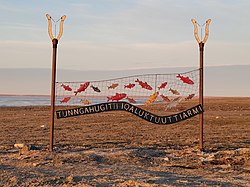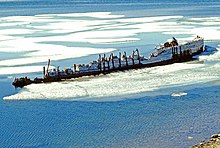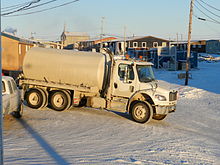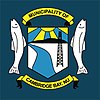
A | B | C | D | E | F | G | H | CH | I | J | K | L | M | N | O | P | Q | R | S | T | U | V | W | X | Y | Z | 0 | 1 | 2 | 3 | 4 | 5 | 6 | 7 | 8 | 9
Cambridge Bay
Iqaluktuuttiaq ᐃᖃᓗᒃᑑᑦᑎᐊᖅ | |
|---|---|
 Tunngahugitti Iqaluktuuttiarmi - Welcome to Cambridge Bay | |
| Nickname: Cam Bay | |
| Coordinates: 69°06′50″N 105°03′10″W / 69.11389°N 105.05278°W[1] | |
| Country | Canada |
| Territory | Nunavut |
| Region | Kitikmeot |
| Electoral district | Cambridge Bay |
| Settled | 1921 |
| Incorporated (hamlet) | 1 April 1984 |
| Government | |
| • Mayor | Wayne Gregory |
| • Senior Administrative Officer | Jim MacEachern |
| • MLA | Pam Gross |
| Area | |
| • Total | 195.70 km2 (75.56 sq mi) |
| • Population Centre | 0.85 km2 (0.33 sq mi) |
| Elevation | 31 m (102 ft) |
| Highest elevation | 183 m (600 ft) |
| Lowest elevation | 0 m (0 ft) |
| Population | |
| • Total | 1,760 |
| • Density | 9.0/km2 (23/sq mi) |
| • Population Centre | 1,403 |
| • Population Centre density | 1,652.9/km2 (4,281/sq mi) |
| Time zone | UTC−07:00 (MST) |
| • Summer (DST) | UTC−06:00 (MDT) |
| Canadian Postal code | |
| Area code | 867 |
| Telephone Exchange | 983 |
| GNBC Code | OADAD |
| NTS Map | 77D2 Cambridge Bay |
| Website | Official site |
Cambridge Bay (Inuinnaqtun: Iqaluktuuttiaq[9] Inuktitut: ᐃᖃᓗᒃᑑᑦᑎᐊᖅ; 2021 population 1,760;[6] population centre 1,403[7]) is a hamlet located on Victoria Island in the Kitikmeot Region of Nunavut, Canada. It is the largest settlement on Victoria Island. Cambridge Bay is named for Prince Adolphus, Duke of Cambridge, while the traditional Inuinnaqtun name for the area is Ikaluktutiak (old orthography) or Iqaluktuuttiaq (new orthography) meaning "good fishing place".
The traditional language of the area is Inuinnaqtun and is written using the Latin alphabet rather than the syllabics of the Inuktitut writing system. Like Kugluktuk, Bathurst Inlet and Umingmaktok, syllabics are rarely seen and used mainly by the Government of Nunavut.[10][11]
Cambridge Bay is the largest stop for passenger and research vessels traversing the Arctic Ocean's Northwest Passage,[12] a disputed area which the Government of Canada claims are Canadian Internal Waters, while other nations state they are either territorial waters or international waters.[13][14]
History
The first known people to occupy the area were the Pre-Dorset people, somewhere around 1800 BCE, about 4,000 years ago, and were seal and caribou hunters.[15] The next group to enter the area were a Paleo-Eskimo peoples known as the Dorset, who arrived approximately 500 CE. They were the first known people to have fished for the Arctic char.[16] The last of the Paleo-Eskimo people, who appeared here about 800 CE, were the Tuniit, and evidence of their living quarters can be seen close to Cambridge Bay. The Tuniit, who were known to the Inuit as giants, were taller and stronger than the Inuit, but were easily scared off.[17][18]

The next group to arrive were the Thule people, ancestors of the modern Inuit, who arrived in the area around 1250 CE from present day Alaska. The Thule people built food caches and stone houses in the area and were noted for their sophisticated tools.[19] Although there is no positive evidence it is suspected that the Thule may have interacted with the Tuniit.[17]
About 500 years ago, around 1500 CE, the modern Inuit made an appearance. Like the Thule they made use of caches, hunted caribou and fished for char. They also hunted seal from the ice in winter and returned to the land in spring. They were also known to make use of inukhuk and built igluit.[20] Although they had no collective name, the various groups of Inuit that made use of native copper for tools have since become known as Copper Inuit and are the same people that Vilhjalmur Stefansson called the Blond Eskimos.[21][22] The main groups that lived or interacted in the Cambridge Bay area were the Ekalluktogmiut (Iqaluktuurmiutat[23] or Ikaluktuurmiut), Ahiagmiut (Ahiarmiut), the Killinirmuit and the Umingmuktogmiut.[24]
The first Europeans to reach Cambridge Bay were overland Arctic explorers led by Thomas Simpson in 1839; they were searching for the Northwest Passage and had crossed the sea ice on foot. Another overland expedition led by John Rae reached Cambridge Bay in 1851, and the first ship to reach the bay was HMS Enterprise under Richard Collinson who wintered there in 1852/53. Both Rae and Collinson were searching for Franklin's lost expedition. Collinson's ship came from the west, having entered the Canadian Arctic via the Bering Strait. This was the furthest east any large ship travelled from the Bering Strait until Henry Larsen's west–east sailing of the Northwest Passage aboard St. Roch in 1941. Cambridge Bay was the site of Royal Canadian Mounted Police (RCMP) and Hudson's Bay Company (HBC) outposts established during the 1920s. Although at this point most Inuit would have continued the traditional lifestyle, and only visited the area rather than live there permanently.[25] The HBC opened a post here in 1921, later than in most places, and built at the site now called the "old town".[26][25] In 1925 the HBC purchased the historic ship Maud, which they renamed the Baymaud, from the creditors of Norwegian explorer, Roald Amundsen. The ship sailed to the Arctic in 1926 but it became stuck in the winter ice at Cambridge Bay.

The Maud was later anchored near the shore and used for various purposes, including the first ever radio weather reports from the Arctic coast.[27] In 1930 the ship sank and, although some material was removed at the time, the ship remained visible for 86 years.[27] A Norwegian plan to salvage the ship and return it to Norway, though initially denied an export permit, was granted on appeal, and was to be carried out in 2014 but was delayed to 2015 due to ice conditions preventing the arrival of salvage equipment until late in the open water season. The planned salvage of 2015 was also delayed, however during the summer of 2016 the Maud was raised and prepared for return to Norway during the summer of 2017, where she will be displayed at a museum in Vollen, Asker.
In 1947 following World War II the Cambridge Bay LORAN Tower was built near the previous location of Cambridge Bay.[25] The construction of the LORAN tower involved hiring Inuit who, after the tower was complete, remained in the area.[25] The tower was demolished 5 August 2014.[28]
In 1954 construction was completed on the Roman Catholic Church. The church, Cambridge Bay's first, was constructed from local material using seal oil and sand as mortar, and was used for services until the 1960s.[25][29] On 27 April 2006, a large portion of the church, which had been designated a heritage site by the Hamlet Council, was destroyed by a fire which the RCMP said was deliberate.[29][30]


A Distant Early Warning Line site was established in 1955 and about 200 Inuit were hired to help in the construction.[25] The military presence and the services and economy this represented acted as a magnet for Inuit who had previously used the area as a temporary site for meeting, hunting, fishing and trade, and a permanent community was soon established across the bay in its current location.[25] Unlike the majority of the DEW Line radar sites which were abandoned or automated, this site which changed in 1989, known as CAM-MAIN, remains a manned operation, with about 18 people, as part of the North Warning System.[31][32]
Originally part of the Fort Smith Region, Northwest Territories, Cambridge Bay became the administrative centre for the Kitikmeot Region, Northwest Territories, and remained so for the new Kitikmeot Region after the 1999 division of the Northwest Territories. In 1982 a division plebiscite was held. Although about 80% of the population then living in what is now Nunavut voted in favour of division, Cambridge Bay was one of only two communities to vote against division. Kugluktuk, then called Coppermine, was the other.[33]
Geography
Situated between Dease Strait[34] and Queen Maud Gulf[26] on the southeast coast of Victoria Island (Kitlineq[35]), part of the Arctic Archipelago,[36] Cambridge Bay is a transportation and administrative centre for the Kitikmeot Region.[37] To the north of the community is Tahiryuaq (also spelt Tahikyoak and formerly Ferguson Lake)[38] which flows into Wellington Bay via the Ekalluk River. The Ekalluk River is both an important commercial fishing and archaeological area,[39] and of particular importance is the short section of the river known as Iqaluktuuq.[23]
About 37 km (23 mi) west of the community lie the Finlayson Islands which were surveyed by Sir Richard Collinson on board HMS Enterprise during his search for the lost expedition of Sir John Franklin.[40]
The area was a traditional hunting and fishing location and archaeological sites are often found. The barren-ground caribou, muskox, Arctic char, lake trout and ringed seal were the primary prey, and remain important food sources. Situated east of Cambridge Bay is Ovayok Territorial Park, which includes the large esker known as Uvayuq, formerly Ovayok or Mount Pelly.[41]
Demographics
| Year | Pop. | ±% |
|---|---|---|
| 1976 | 616 | — |
| 1981 | 815 | +32.3% |
| 1986 | 1,002 | +22.9% |
| 1991 | 1,116 | +11.4% |
| 1996 | 1,351 | +21.1% |
| 2001 | 1,309 | −3.1% |
| 2006 | 1,477 | +12.8% |
| 2011 | 1,608 | +8.9% |
| 2016 | 1,766 | +9.8% |
| 2021 | 1,760 | −0.3% |
| Source: Statistics Canada [6][42][43][44][45][46][47][48][49] | ||
In the 2021 Canadian census conducted by Statistics Canada, Cambridge Bay had a population of 1,760 living in 571 of its 701 total private dwellings, a change of -0.3% from its 2016 population of 1,766. With a land area of 195.78 km2 (75.59 sq mi), it had a population density of 9.0/km2 (23.3/sq mi) in 2021.[6]
The median age of the population in 2021 was 30.4 and 76.1% of the people were over 15.[50] Both of these figures are slightly higher than the numbers for Nunavut as a whole (25.6 and 67.5%).[50] In 2021, 82.4% (Nunavut: 85.2%) of the population were listed as Indigenous and 17.6% (Nunavut: 14.8%) as non-Aboriginal. Of the total population 79.5% (Nunavut: 83.7%) were Inuit, 0.9% (Nunavut: 0.3%) Métis and 0.6% (Nunavut: 0.5%) First Nations.[50]
| Panethnic group | 2021[51] | 2016[52] | 2011[53] | 2006[54] | 2001[55] | |||||
|---|---|---|---|---|---|---|---|---|---|---|
| Pop. | % | Pop. | % | Pop. | % | Pop. | % | Pop. | % | |
| Indigenous | 1,450 | 83.09% | 1,465 | 84.44% | 1,290 | 81.39% | 1,215 | 82.37% | 1,035 | 79.01% |
| European[a] | 215 | 12.32% | 225 | 12.97% | 260 | 16.4% | 235 | 15.93% | 260 | 19.85% |
| African | 35 | 2.01% | 20 | 1.15% | 10 | 0.63% | 10 | 0.68% | 20 | 1.53% |
| Southeast Asian[b] | 20 | 1.15% | 10 | 0.58% | 15 | 0.95% | 20 | 1.36% | 0 | 0% |
| South Asian | 20 | 1.15% | 10 | 0.58% | 0 | 0% | 10 | 0.68% | 0 | 0% |
| Latin American | 10 | 0.57% | 0 | 0% | 0 | 0% | 0 | 0% | 0 | 0% |
| East Asian[c] | 0 | 0% | 10 | 0.58% | 0 | 0% | 10 | 0.68% | 0 | 0% |
| Middle Eastern[d] | 0 | 0% | 10 | 0.58% | 0 | 0% | 0 | 0% | 0 | 0% |
| Other/multiracial[e] | 20 | 1.15% | 0 | 0% | 0 | 0% | 10 | 0.68% | 0 | 0% |
| Total responses | 1,745 | 99.15% | 1,735 | 98.24% | 1,585 | 98.57% | 1,475 | 99.86% | 1,310 | 100.08% |
| Total population | 1,760 | 100% | 1,766 | 100% | 1,608 | 100% | 1,477 | 100% | 1,309 | 100% |
| Note: Totals greater than 100% due to multiple origin responses | ||||||||||
Canadian High Arctic Research Station campus

Cambridge Bay is the location of the Canadian High Arctic Research Station (CHARS)[56] campus as announced by Prime Minister Stephen Harper on 24 August 2010.[57] This multidisciplinary station is operated year-round by Polar Knowledge Canada, a federal agency. It is a keystone of Canada's Northern Strategy.[58] Its mandate is stated:
To be a world-class research station in Canada's Arctic that is on the cutting edge of Arctic issues. The Station will anchor a strong research presence in Canada's Arctic that serves Canada and the world. It will advance Canada's knowledge of the Arctic in order to improve economic opportunities, environmental stewardship, and the quality of life of Northerners and all Canadians.
Cambridge Bay was chosen after a feasibility study that also included Pond Inlet and Resolute as potential locations.[60] Prime Minister Harper announced that, starting in 2012, the Government of Canada would spend $142.4 million over a six-year period to build, equip and provision the station. Additionally, again starting in 2012 and spread over six years, the government would provide $46.2 million for the CHARS Science and Technology Program.[61] The prime minister stated that to provide for the continuing research and operations $26.5 million per year, beginning in 2018–19, would be made available.[62] It is expected that the station will provide 35 to 50 jobs. These jobs, which will be full-time, part-time and seasonal, will start in 2017 and run the Science and Technology Program as well as provide the day-to-day operations of the station. In addition it is expected that 150 jobs will be created during construction for local and other people throughout the north. However, some of these jobs will require the hiring of specialised people from southern locales.[63] Construction began in August 2014.[64]
Education


Several educational services are available, including daycare,[65] preschool, Kullik Ilihakvik (elementary school) named for the traditional stone lamp the qulliq, Killinik High School, and a public library[26] and museum located in the high school.[66] The community is also the regional centre for the Kitikmeot Campus of Nunavut Arctic College who oversee the Cambridge Bay Community Learning Centre. Courses range from Adult Basic Education to the Nunavut Teacher Education Program (NTEP), which, in partnership with the University of Regina, is able to offer a Bachelor of Education.[67][68][69]
Land claims
The Kitikmeot Inuit Association, Nunavut Impact Review Board, and Nunavut Planning Commission have offices in Cambridge Bay, as well as the Lands and Resources Department of Nunavut Tunngavik Incorporated.[70][71][72][73]
Religion
There are three churches in Cambridge Bay: St. George's Anglican Church, which is part of the Diocese of Arctic,[74] Our Lady of the Arctic Roman Catholic Church, which is part of the Diocese of Mackenzie-Fort Smith,[75] and the Glad Tidings Pentecostal Church.[76]
Economy and infrastructure

There are several businesses in the community and these include a Northern Store which includes a Quick Stop, selling KFC and Pizza Hut products,[77] the Ikaluktutiak Co-operative, part of the Arctic Co-operatives Limited,[78] a branch of the Royal Bank of Canada[79] and a stand-alone Canada Post postal service.[80] Other community businesses include Jago Services, plumbing and electrical,[81] Qillaq operates construction services, mechanics shop, heating fuel and gasoline sales as well as a service garage. Kalgen's operates the Dis & Dat Convenience Store and a separate Dis & Dat Hardware Division (formerly Kitikmeot Supplies), a hardware store. Kalvik Enterprises and Nanook Woodworking, both construction companies[82][83] and Inukshuk Enterprises, a general contractor, who also operate a service garage and a convenience store.[84] The Canadian High Arctic Research Station also provides some local employment.
There is a modern health centre, the Kitikmeot Regional Health Centre, in the community that opened in 2005. It provides facilities that were previously unavailable in the region, however certain procedures still require a trip to Yellowknife or Edmonton. In 2010 the birthing centre was opened in the same building and included local midwives.[85] In 2017, the long term residential care unit was opened upstairs at the Kitikmeot Regional Health Centre.[86] There is a RCMP detachment in Cambridge Bay and the Kitikmeot Law Centre has its offices in the community.[87][88] The hotels include the Umingmak Lodge Bed and Breakfast, the Arctic Islands Lodge, run by the Co-op and the Green Row operated by Inukshuk Enterprises.[89][90][91]
Phone service is provided by Northwestel, a division of BCE Inc. and, with their companion Bell Mobility, also handle cell phone coverage.[92][93] Buildings in Cambridge Bay, like in most Nunavut communities, have water and sewage tanks that require regular services by truck. These services along with garbage pick-up are done by the Hamlet.[94]
Media

Radio
| Frequency | Call sign | Branding | Format | Owner | Notes |
|---|---|---|---|---|---|
| FM 97.7 | CFBI-FM | – | Community radio | Cambridge Bay Communications Society | Broadcasts programming in English and Inuinnaqtun |
| FM 101.9 | CFFB-1-FM | CBC Radio One | Talk radio, public radio | Canadian Broadcasting Corporation | Rebroadcaster of CFFB (Iqaluit) |
| FM 105.1 | CBIN-FM | CBC Radio One | Talk radio, public radio | Canadian Broadcasting Corporation | Rebroadcaster of CHAK (Inuvik) |
Cambridge Bay is served by two CBC Radio One rebroadcasters to allow residents to hear Inuvialuktun language programming, which is the language spoken in Cambridge Bay, that is aired in the afternoons by CHAK.
Television
- Channel 9 – CBENT, CBC North went dark 31 July 2012[95]
- Channel 51 is a local channel run by the Kitikmeot Inuit Association featuring local and territorial films, videos and documentaries.
Cable television is available from the local Co-op[78] and satellite television from either Shaw Direct or Bell Satellite TV.

Internet services
- Northwestel High Speed Internet, DSL
- Qiniq, broadband Internet service provider for Nunavut. The community has been served by the Qiniq network since 2005. Qiniq is a fixed wireless service to homes and businesses, connecting to the outside world via a satellite backbone. The Qiniq network is designed and operated by SSi Canada. In 2017, the network was upgraded to 4G LTE technology, and 2G-GSM for mobile voice.
- Starlink, a satellite internet constellation operated by SpaceX,[96] providing satellite Internet access[97]
Transportation

Although Cambridge Bay lies on the Northwest Passage, there are no passenger ships other than tourist cruises. Lines include NEAS[98] (from Nunavut and Nunavik[99]) and Nunavut Sealink and Supply,[100] Arctic Co-operatives Limited, Desgagnes Transarctik, the Qikiqtaaluk Corporation, Sakku Investments Corporation and the Kitikmeot Corporation.[101] provide annual sealift to the community.
The only passenger services are through the Cambridge Bay Airport, from which daily air service to Yellowknife and other Kitikmeot Region communities are offered by Canadian North.[102]
Charter and MEDIVAC (air ambulance) services are provided by Keewatin Air. Former MEDIVAC operator Adlair Aviation still operates charters in the region. In the summer floatplane charters are provided by DAL Aviation from the Cambridge Bay Water Aerodrome.[103]
In 2012, the roads of Cambridge Bay were imaged for Google Street View by a tricycle fitted with a camera system.[104] While Cambridge Bay had no cars at the time (only snowmobiles, ATVs, SUVs, buses and trucks), Google responded to a proposal by Cambridge Bay resident Chris Kalluk to include Arctic communities in Street View in order to educate the rest of the world.[104] Through Google Street View, one can even enter the indoor swimming pool and have a look around.
Climate
Cambridge Bay has a polar climate, no month having an average temperature of 10 °C (50 °F) or higher, and is listed as ET on the Köppen climate classification.[105] It has never recorded a temperature above freezing between 31 October and 19 April.[106] Summers are typically cool and rainy, with pleasant days and chilly nights. Winters are cold, dark, and long, with October being the snowiest month. Snowfall and frosts are possible all year round, though rare during July. Rainfall is usually limited to the summer months of June to September, when the temperature rises above freezing for a few months before dipping back down for another nine months of winter. Average high temperatures reach freezing around June 1 and drop below freezing around September 24. Springs are typically sunny but still very chilly. Autumns are short and crisp, with more frequent cloud cover starting to appear during August and with September being almost constantly cloudy.
The sun is continuously below the horizon, polar night, from approximately 30 November to 11 January and above the horizon, midnight sun, 19 May to 22 July.[107]
| Climate data for Cambridge Bay (Cambridge Bay Airport) WMO ID: 71925; coordinates 69°06′29″N 105°08′18″W / 69.10806°N 105.13833°W; elevation: 31.1 m (102 ft); 1991–2020 normals | |||||||||||||
|---|---|---|---|---|---|---|---|---|---|---|---|---|---|
| Month | Jan | Feb | Mar | Apr | May | Jun | Jul | Aug | Sep | Oct | Nov | Dec | Year |
| Record high humidex | −5.0 | −9.7 | −4.1 | 3.9 | 10.5 | 25.3 | 30.8 | 28.6 | 16.3 | 5.8 | −1.4 | −3.5 | 30.8 |
| Record high °C (°F) | −4.9 (23.2) |
−9.4 (15.1) |
−4.0 (24.8) |
6.1 (43.0) |
11.5 (52.7) |
23.3 (73.9) |
28.9 (84.0) |
26.1 (79.0) |
16.4 (61.5) |
6.9 (44.4) |
0.0 (32.0) |
−3.4 (25.9) |
28.9 (84.0) |
| Mean daily maximum °C (°F) | −27.7 (−17.9) |
−28.6 (−19.5) |
−24.9 (−12.8) |
−16.2 (2.8) |
−5.2 (22.6) |
6.0 (42.8) |
13.3 (55.9) |
10.3 (50.5) |
2.6 (36.7) |
−6.6 (20.1) |
−17.5 (0.5) |
−24.3 (−11.7) |
−9.9 (14.2) |
| Daily mean °C (°F) | −31.2 (−24.2) |
−32.1 (−25.8) |
−28.8 (−19.8) |
−20.7 (−5.3) |
−8.9 (16.0) |
3.0 (37.4) |
9.4 (48.9) |
7.4 (45.3) |
0.5 (32.9) |
−9.5 (14.9) |
−21.1 (−6.0) |
−27.8 (−18.0) |
−13.3 (8.1) |
| Mean daily minimum °C (°F) | −34.6 (−30.3) |
−35.6 (−32.1) |
−32.7 (−26.9) |
−25.1 (−13.2) |
−12.6 (9.3) |
0.0 (32.0) |
5.4 (41.7) |
Zdroj:https://en.wikipedia.org?pojem=Cambridge_Bay,_Nunavut||||||



